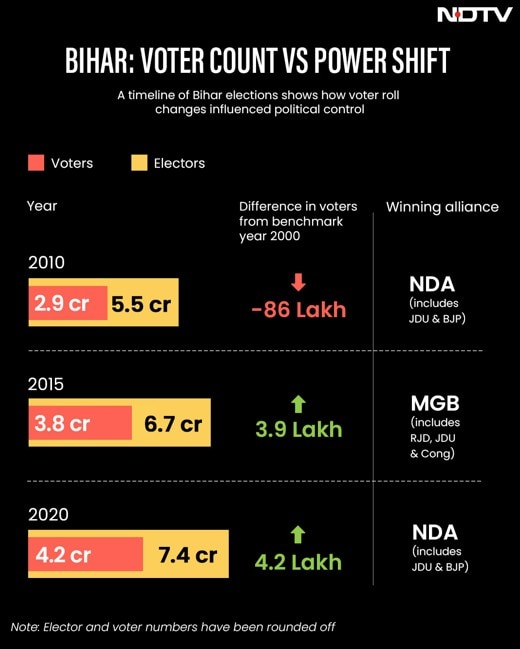The latest Special Intensive Revision (SIR) of Bihar's electoral roll has concluded with a significant reduction of 51 lakh voters, amounting to a 6% drop from the rolls as of May 2025.
In comparison, the previous SIR conducted between 2002 and 2003 led to a sharper 14% reduction in eligible voters. However, that exercise was spread over a longer period and occurred between two elections, not immediately before one. As a result, the revelation that more than one in ten voters were either ineligible or non-existent did not spark the kind of debate we're witnessing today.
A detailed analysis of the electoral impact of both revisions offers a trove of insights into why this current exercise could significantly shape the upcoming election outcome.
Historical Benchmarks and Electoral Shifts
Working on an analysis that benchmarks all elections since the 2000 Bihar Assembly election tracks the reduction in voter numbers, turnout trends, and electoral outcomes.
The first election after the 2002-03 revision was held in February 2005. The voter count had dropped from approximately 6 crore to 5.26 crore. The result was a hung assembly, with the UPA led by Lalu Prasad Yadav struggling to retain power. By October 2005, the voter count further declined to 5.13 crore under the vigilant oversight of Election Commissioner KJ Rao. This election delivered a clear majority to the NDA, which won 143 of the 243 seats.

Interestingly, as long as the absolute number of voters remained below the pre-SIR benchmark of 2000, the NDA maintained its dominance. The 2010 election was a landslide for the NDA. While many contextual factors influenced these outcomes, the correlation with voter count benchmarks is hard to ignore.
However, as voter numbers began inching back toward the 2000 levels, the NDA's grip weakened. In 2015, they lost. In 2020, they scraped through with a razor-thin margin-just 0.03% of the vote. While factors like the LJP's role and Nitish Kumar's shifting alliances were critical, one unmistakable pattern emerged: lower voter counts tend to favour BJP-led alliances. This seems to be an implicit understanding shared by both the BJP and its rivals.
Why This SIR Matters More
If the current SIR reduced voters by 6%, that is less than the 14% reduction of the previous one, why does it feel more consequential?
A microscopic look at the 2020 results reveals the answer. The NDA won the state by a margin of just 11,150 votes, narrower than the margin in many individual assembly seats. Had just 12 seats swung the other way, Bihar would have had a different Chief Minister.
In fact, only 6,292 voters across those 12 seats needed to vote differently to change the outcome. That's what makes this SIR so pivotal. Even a few hundred ineligible or non-existent voters could tip the balance in multiple constituencies.
The average margin across the state was 16,832 votes, or roughly 10%. Yet the distribution of support for both the ruling party and the opposition was so evenly spread that small shifts could have led to dramatically different results.
The Jan Suraj Factor and Caste Dynamics
Adding to the complexity is the emergence of Prashant Kishor's Jan Suraj Party, which is expected to cut across caste lines and appeal to a broad voter base. This new entrant could disrupt traditional voting patterns and further fragment the vote.
A parallel can be drawn with Maharashtra's 2024 Lok Sabha election, where the NDA and the Congress-led alliance were separated by just 0.5% in vote share. Despite the narrow margin, the NDA suffered a decisive defeat. However, the NDA's women-centric welfare schemes, especially the Ladli Bahin initiative, helped them break caste barriers and reach deeper into the electorate than ever before.
This experience has likely informed the NDA's strategy in Bihar, where they hope to replicate that success and appeal beyond traditional caste lines, much like Jan Suraj aims to do.
A New Political Landscape
This election marks several firsts for Bihar:
A serious attempt to triangulate Bihar's politics, long after the CPI(ML) and Left Front ceased to be major players.
The rise of younger leaders in RJD and Jan Suraj, while the BJP banks on a coalition of EBC (Extremely Backward Class) leaders.
Possibly the largest pre-election outreach to women voters in Bihar's history.
An SIR conducted closer to the election than ever before.
It's a heady mix-new players, shifting alliances, and a finely balanced electorate. Many years ago, a state tourism department used the tagline "Full of Surprises." Today, that phrase perfectly captures the mood of Bihar's 2025 election.
(The author is co-founder of VMR (Votersmood Research) and founder of M76 Analytics. You can follow him @JMAI799249 on X)
Disclaimer: These are the personal opinions of the author



